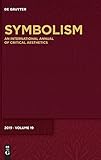Symbolism 2019 : Special Focus: Beyond Mind / ed. by Natasha Lushetich.
Material type: TextSeries: Symbolism : An International Annual of Critical Aesthetics ; 19Publisher: Berlin ; Boston : De Gruyter, [2019]Copyright date: ©2020Description: 1 online resource (XI, 334 p.)Content type:
TextSeries: Symbolism : An International Annual of Critical Aesthetics ; 19Publisher: Berlin ; Boston : De Gruyter, [2019]Copyright date: ©2020Description: 1 online resource (XI, 334 p.)Content type: - 9783110667486
- 9783110635539
- 9783110634952
- 809 23
- PN56.S9 .S963 2019
- online - DeGruyter
- Issued also in print.
| Item type | Current library | Call number | URL | Status | Notes | Barcode | |
|---|---|---|---|---|---|---|---|
 eBook
eBook
|
Biblioteca "Angelicum" Pont. Univ. S.Tommaso d'Aquino Nuvola online | online - DeGruyter (Browse shelf(Opens below)) | Online access | Not for loan (Accesso limitato) | Accesso per gli utenti autorizzati / Access for authorized users | (dgr)9783110634952 |
Browsing Biblioteca "Angelicum" Pont. Univ. S.Tommaso d'Aquino shelves, Shelving location: Nuvola online Close shelf browser (Hides shelf browser)
Frontmatter -- Foreword from the Editors -- Acknowledgements -- Contents -- Special Focus: “Beyond Mind” -- Introduction -- Part I: “Ahistoricity, Assemblages and Interpretative Reversals” -- The Fullness of Nothing, the Sense of the Nonsensical, and the Value of Being Unproductive -- Automatic Writing: From Networked Art to Cyberwarfare -- Cracking the Beckettian Profounds of Mind in Endgame with Game Theory -- Part II: “Destinerrance, Labyrinths and Folds” -- “The End Is Built into the Beginning”: Charlie Kaufman and the Orderly Disorder of Neuroscience -- The Fold: Musical Monads and Baroque Assemblages -- The Liquid Architecture of Bodily Folding -- Part III: “Immanent Transcendence” -- Herat 1487: Early Virtual Reality -- “Aesthetic Borderlands” in Peter Greenaway’s Prospero’s Books -- The White Space Conflict Theory: Understanding Photography as Energy -- General Section -- Panopticon and Pilgrimage: The Narrator- Reader Relationship in Henry Fielding’s Joseph Andrews -- Language, Symbol, and “Non-Symbolic Fact” in D. G. Rossetti’s “The Woodspurge” -- Art Nouveau and Interarts in A. S. Byatt’s The Children’s Book -- Book Reviews -- Barbara Franchi, Elvan Mutlu, eds. Crossing Borders in Victorian Travel: Spaces, Nations and Empires -- Marion Gymnich, Barbara Puschmann-Nalenz et. al. The Orphan in Fiction andComics since the 19th Century -- Review Essay: Recent Studies in Renaissance Aesthetics -- Review Essay: World-Building in Literatureand Beyond -- List of Contributors -- Index
restricted access online access with authorization star
http://purl.org/coar/access_right/c_16ec
Special Focus editor: Natasha LushetichSeries editors: Rüdiger Ahrens, Florian Kläger, Klaus Stierstorfer Symbolism is cohesive. It gathers heterogeneity over time, across fields of human endeavor and systems of communication. Non-sequiturs, paradox and tautology, appear dissipative. Yet they are highly productive in reticular and fractal ways. Suffice it to look at the philosophical tautology of Parmenides’s kind, which suggests that being "is"; at the practice of the koan, which collapses dualistic thinking by way of incompatible propositions, such as "the Eastern hill keeps running on the water"; at logical paradoxes in which the operative logic is sabotaged by its own means, as in Hempel’s paradox; at absurdist dramatic texts in which protagonists record empty time in order to mark the emptiness of the time they are recording, as in Beckett’s Krapp’s Last Tape; or at paradoxical games like Maciunas’s Prepared Table Tennis played with paddles that have huge holes in them. In all of these examples, the existence-apprehending processes occur via unexpected itineraries, in vacant but nevertheless enunciative codes, in seemingly futile, yet calibrating performances, and in a temporality that is the cumulative time’s "other." They catapult the mind into the realm of the extra-linguistic, the para-logical and the meta-experiential, or they transfigure it through a series of reticular iterations. Forty years after Varela et al’s groundbreaking work on the embodied, emotional and environmentally embedded mind – that marked a definitive departure from its former strictly rational conception – there is a need to re-examine the territory that lies beyond mind for a different reason: the proliferation of algorithmic logics that rely on the idea of a rational agent (human or algorithmic) making logical, self-serving decisions. This special issue explores neither-rational-nor-irrational forms of thinking and making. It sketches a cartography of a-rational processes of meaning- and knowledge-production that operate across numerous sites, practices, and disciplines: visual and media art; literature; art history; music; dance; film; intermedia and photography. Part I "Ahistoricity, Assemblages and Interpretative Reversals" focuses on the legacy of the (neo) avant-garde and amodernism. Part II "Destinerrance, Labyrinths and Folds" investigates the ways in which the Derridian delays/detours and the Deleuzian folding function as concrete ways of embodied knowledge-production. Part III, "Immanent Transcendence", offers a glimpse into the reticular and iterative structuring of transcendence that does not pre-exist immanence but is its residue.
Issued also in print.
Mode of access: Internet via World Wide Web.
In English.
Description based on online resource; title from PDF title page (publisher's Web site, viewed 25. Jun 2024)









